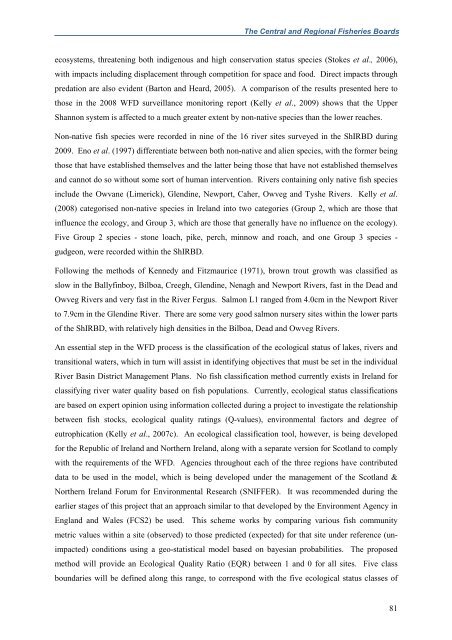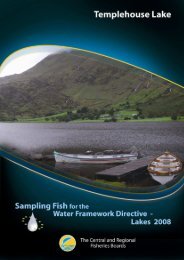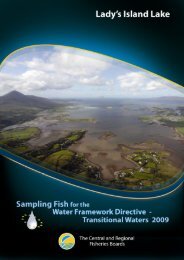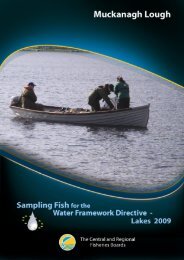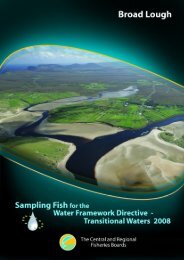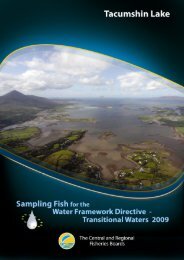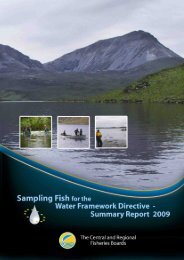HERE - Inland Fisheries Ireland
HERE - Inland Fisheries Ireland
HERE - Inland Fisheries Ireland
Create successful ePaper yourself
Turn your PDF publications into a flip-book with our unique Google optimized e-Paper software.
The Central and Regional <strong>Fisheries</strong> Boards<br />
ecosystems, threatening both indigenous and high conservation status species (Stokes et al., 2006),<br />
with impacts including displacement through competition for space and food. Direct impacts through<br />
predation are also evident (Barton and Heard, 2005). A comparison of the results presented here to<br />
those in the 2008 WFD surveillance monitoring report (Kelly et al., 2009) shows that the Upper<br />
Shannon system is affected to a much greater extent by non-native species than the lower reaches.<br />
Non-native fish species were recorded in nine of the 16 river sites surveyed in the ShIRBD during<br />
2009. Eno et al. (1997) differentiate between both non-native and alien species, with the former being<br />
those that have established themselves and the latter being those that have not established themselves<br />
and cannot do so without some sort of human intervention. Rivers containing only native fish species<br />
include the Owvane (Limerick), Glendine, Newport, Caher, Owveg and Tyshe Rivers. Kelly et al.<br />
(2008) categorised non-native species in <strong>Ireland</strong> into two categories (Group 2, which are those that<br />
influence the ecology, and Group 3, which are those that generally have no influence on the ecology).<br />
Five Group 2 species - stone loach, pike, perch, minnow and roach, and one Group 3 species -<br />
gudgeon, were recorded within the ShIRBD.<br />
Following the methods of Kennedy and Fitzmaurice (1971), brown trout growth was classified as<br />
slow in the Ballyfinboy, Bilboa, Creegh, Glendine, Nenagh and Newport Rivers, fast in the Dead and<br />
Owveg Rivers and very fast in the River Fergus. Salmon L1 ranged from 4.0cm in the Newport River<br />
to 7.9cm in the Glendine River. There are some very good salmon nursery sites within the lower parts<br />
of the ShIRBD, with relatively high densities in the Bilboa, Dead and Owveg Rivers.<br />
An essential step in the WFD process is the classification of the ecological status of lakes, rivers and<br />
transitional waters, which in turn will assist in identifying objectives that must be set in the individual<br />
River Basin District Management Plans. No fish classification method currently exists in <strong>Ireland</strong> for<br />
classifying river water quality based on fish populations. Currently, ecological status classifications<br />
are based on expert opinion using information collected during a project to investigate the relationship<br />
between fish stocks, ecological quality ratings (Q-values), environmental factors and degree of<br />
eutrophication (Kelly et al., 2007c). An ecological classification tool, however, is being developed<br />
for the Republic of <strong>Ireland</strong> and Northern <strong>Ireland</strong>, along with a separate version for Scotland to comply<br />
with the requirements of the WFD. Agencies throughout each of the three regions have contributed<br />
data to be used in the model, which is being developed under the management of the Scotland &<br />
Northern <strong>Ireland</strong> Forum for Environmental Research (SNIFFER). It was recommended during the<br />
earlier stages of this project that an approach similar to that developed by the Environment Agency in<br />
England and Wales (FCS2) be used. This scheme works by comparing various fish community<br />
metric values within a site (observed) to those predicted (expected) for that site under reference (unimpacted)<br />
conditions using a geo-statistical model based on bayesian probabilities. The proposed<br />
method will provide an Ecological Quality Ratio (EQR) between 1 and 0 for all sites. Five class<br />
boundaries will be defined along this range, to correspond with the five ecological status classes of<br />
81


